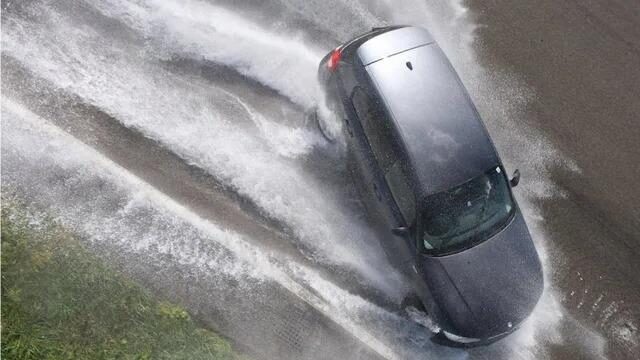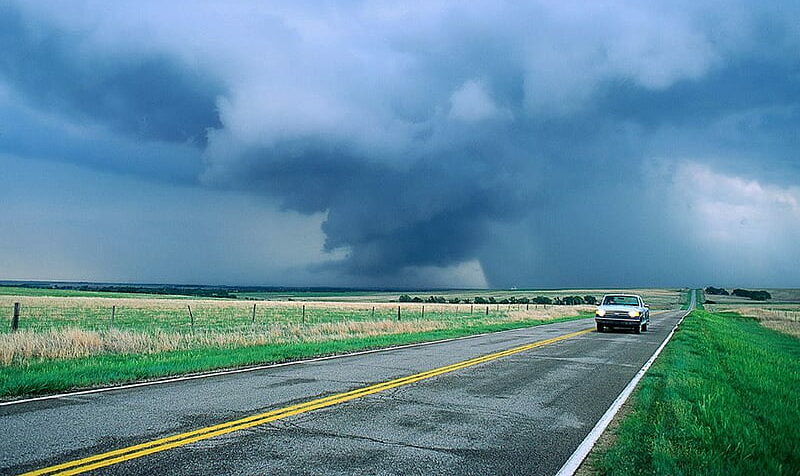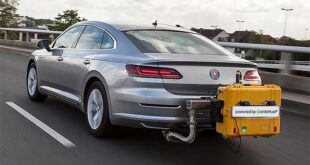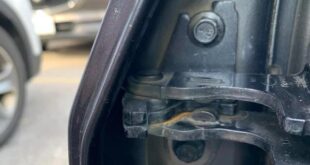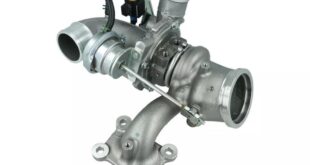The so-called aquaplaning the vehicle floats on the road and the driver has no influence on the steering or the brakes. Many ask themselves how to behave in such a situation and who is liable for the damage if an accident does occur? We have the answers. There is several causes, which trigger aquaplaning. In most cases it is a combination of several things. The basic requirement for aquaplaning is water on the roadway. However, it should be noted that not all rain leads to aquaplaning, as the vehicle's tires are exposed to the water normally push away. When the water is displaced, it flows to the left and right of the tire past. But if the amount of water is very high, the displacement can no longer take place correctly. If there is too much water, a water wedge, who slides under the tire. This increases the grip between the tires and the road verloren. Due to the lack of traction, it is not possible to brake or steer the vehicle. In order to be able to brake or steer, it is necessary for the vehicle to have traction. Incidentally, motorcyclists are less likely to experience aquaplaning.
Do the tires matter?
Incidentally, the amount of water is not the only cause of aquaplaning. Another factor is the tires. Depending on their dimensions and properties, these can make aquaplaning more likely. As a result, wide tires tend to lose traction more quickly. This is because they have a harder time displacing the water to the outside. With narrower tires, the water can be displaced more easily and thus flow past the tire on the left and right. Are the roads responsible for aquaplaning? In addition to the water and the tires, the Street be a factor in aquaplaning. When a road is heavily trafficked, so-called ruts occur. The water collects in these, which promotes aquaplaning. This happens primarily when the road does not have a significant incline and the water cannot drain off as a result. But even on seemingly perfect roads, aquaplaning can occur in heavy rain and at high speeds. For this reason you should always drive carefully in the rain!
Is speed responsible?
Speeding on a wet road can lead to aquaplaning. As a rule, you should be on a significantly wet road surface and in the rain no faster than 80 km / h drive. If the speed is higher, the risk of aquaplaning is significantly increased. For this reason, aquaplaning primarily occurs on motorways and federal roads. Incidentally, if very large amounts of water and worn-out tires are involved, aquaplaning (the float up) coming from the vehicle.
Behavior in the event of aquaplaning!
If aquaplaning occurs and the vehicle floats on the roadway, you have to rinse and correct act. If control of the vehicle is lost, one should remain calm and take the correct steps. This is the only way to prevent something worse from happening. When aquaplaning, the following five steps should be observed:
- No gas: If the speed is reduced, the potential impact in an accident is reduced. If aquaplaning occurs, you should take your foot off the accelerator and, if necessary, the engine disengage (Neutral). With an automatic, the current speed level should be maintained.
- Braking prohibited: Braking is not possible because of the loss of traction. But you shouldn't try to slow down either. If the tires regain traction for a short time, there may be sudden deceleration, which could result in an accident.
- Driving prohibited: The tires of the vehicle should always be parallel to the road. For this reason, you should hold the steering wheel tightly. If the vehicle drifts, the first impulse is to countersteer. However, this is useless and can even lead to worse accidents.
- Accelerating prohibited: The speed should not be increased under any circumstances. Even if you assume that this will get you out of danger faster, accelerating can actually make the situation worse.
- Switching on the low beam: The vehicle must be recognizable to all other participants. For this reason, the low beam should also be switched on during the day. Especially when it rains, vehicles can optically blur/disappear.
When the vehicle regains traction and the driver regains control, it is advisable to continue driving at a slow speed. Depending on the weather, you should decide for yourself whether to continue cautiously or take a break. Since this is a dangerous situation, it is advisable to take a short break to calm down.
How can aquaplaning be prevented?
To avoid aquaplaning, the first thing you should do when it rains is drive carefully. This is of great importance for prevention. If the road has ruts, it is advisable to drive offset to these. And a possible aquaplaning can also be prevented/reduced by observing the road traffic regulations (information on signs etc.) and regular maintenance of the vehicle. But are there any warning signs? It should be noted that there are many signs that herald aquaplaning. When these come up, the speed should reduced or directly one Break be inserted. Caution should be exercised with these signs:
- When it rains heavily (heavy rain), aquaplaning can quickly occur. You should drive slowly and turn the radio down. This means that any warning signals can be better perceived.
- The loud rushing of water or other water noises can be a sign of impending aquaplaning.
- If a noticeable spray is visible on the vehicle's tires, the risk of aquaplaning is very high.
- Caution is also required if the steering wheel is difficult to steer.
Prepare the vehicle!
Tires with a good profile have good traction. tires with one Tread depth of less than 1,6 millimeters are considered in the road traffic regulations abgefahren. This means that they are no longer permitted on the road. If you drive with them, you may be fined. But also for yourself, it is advisable to always close the tires check. So that the danger of worn tires does not arise, they should have a tread depth of 3,0 millimeters change. This also reduces the risk of aquaplaning. Likewise, should always correct air pressure be present in the tires.
Prepare for aquaplaning
In the driving school you learn everything about aquaplaning. But for many, driving school was a few years ago. Also, this is only theoretical knowledge. The correct behavior is not practiced in the driving school, but only briefly internalized. This can be done by participating in a so-called Driving safety training be changed. In such a training that plays aquaplaning an important role. The correct behavior is learned there. In an emergency, you know how to react correctly and safely. Correct action is also important in other dangerous situations Driving safety training learns.
Does insurance pay for damage caused by aquaplaning?
Drivers must contact the respective Weather conditions can customize. This is stipulated in the road traffic regulations. As soon as it rains, you have to assume that aquaplaning can occur. Thus, in heavy rain the speed will be reduced. In the best case, in heavy rain, as already mentioned above, you should take a breakuntil the weather improves. If you continue driving anyway and an accident is caused, you are usually to blame and have to bear the costs yourself. Tip: Blaming the city/municipality for bad roads and aquaplaning fails in most cases. However, there are some insurance companies that also pay for accidents caused by aquaplaning. This includes the Motor vehicle liability insurance and the Fully comprehensive.
Motor vehicle liability insurance covers the following costs:
- Anyone who owns a vehicle is required to have one Motor vehicle liability insurance be locked if the vehicle is to be used on public roads. This protects the user, but also others. This means that in the event of an accident involving another vehicle, someone else's property, or personal injury, motor vehicle liability insurance will cover the cost of the driver. But insurance covers damage to your own vehicle not on.
Fully comprehensive insurance covers the following costs
- Completing the Fully comprehensive is voluntary. If the driver has taken out fully comprehensive insurance, this covers the damage on your own vehicle. Here, depending on the policy, only a small one own contribution paid and the rest is covered by comprehensive insurance. But the protection of the insurance is tied to a few conditions. For example, the tread depth the tires are at least 1,6 millimeters. Failure to do so may result in loss of insurance coverage. This always depends on the conditions that are stored in the policy documents. In any case, should discord the tread depth and generally the Roadworthiness be checked by the vehicle, regardless of the insurance. This can result in accidents, aquaplaning and loss of insurance coverage be prevented.
Of course, that wasn't the end of it!
tuningblog has countless other articles on the subject of car and auto tuning in stock. Do you want to see them all? Just click HERE and look around. In part, we would like to provide you with news but also off the tuning. In our category Tips, products, information & Co We have reviews of car or accessories manufacturers, new ones Tuning Wiki Terms or one or the other Leak veröffentlicht. Just click on one of the following posts!
other related posts
|
Step on the gas again? New technology enables retrofitting to LPG! |
|
 tuningblog.eu Your magazine about tuning the car
tuningblog.eu Your magazine about tuning the car
